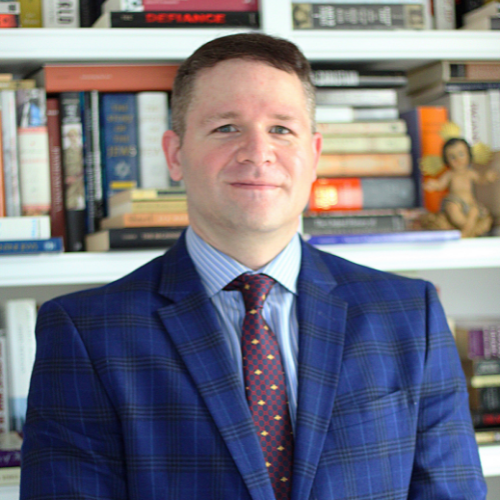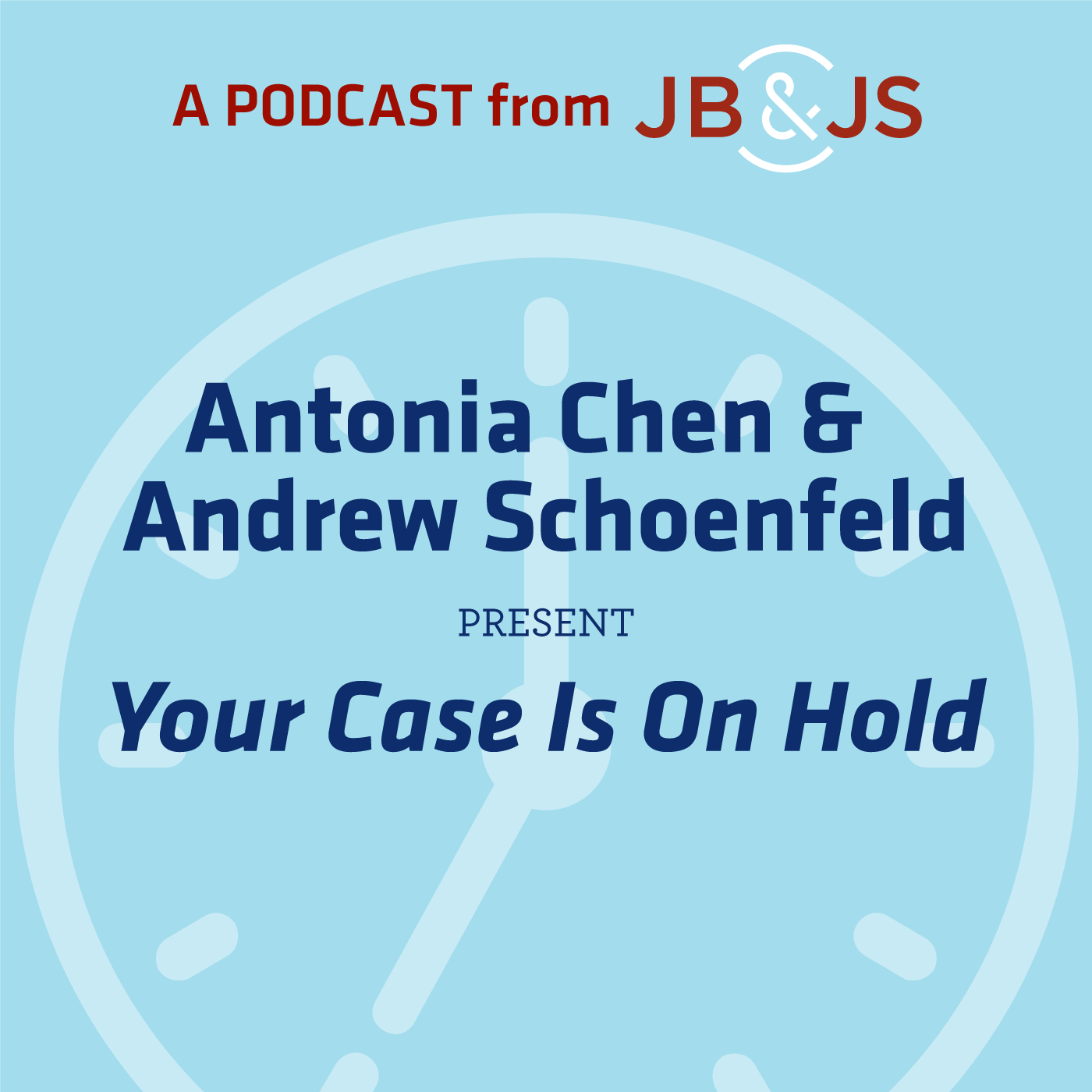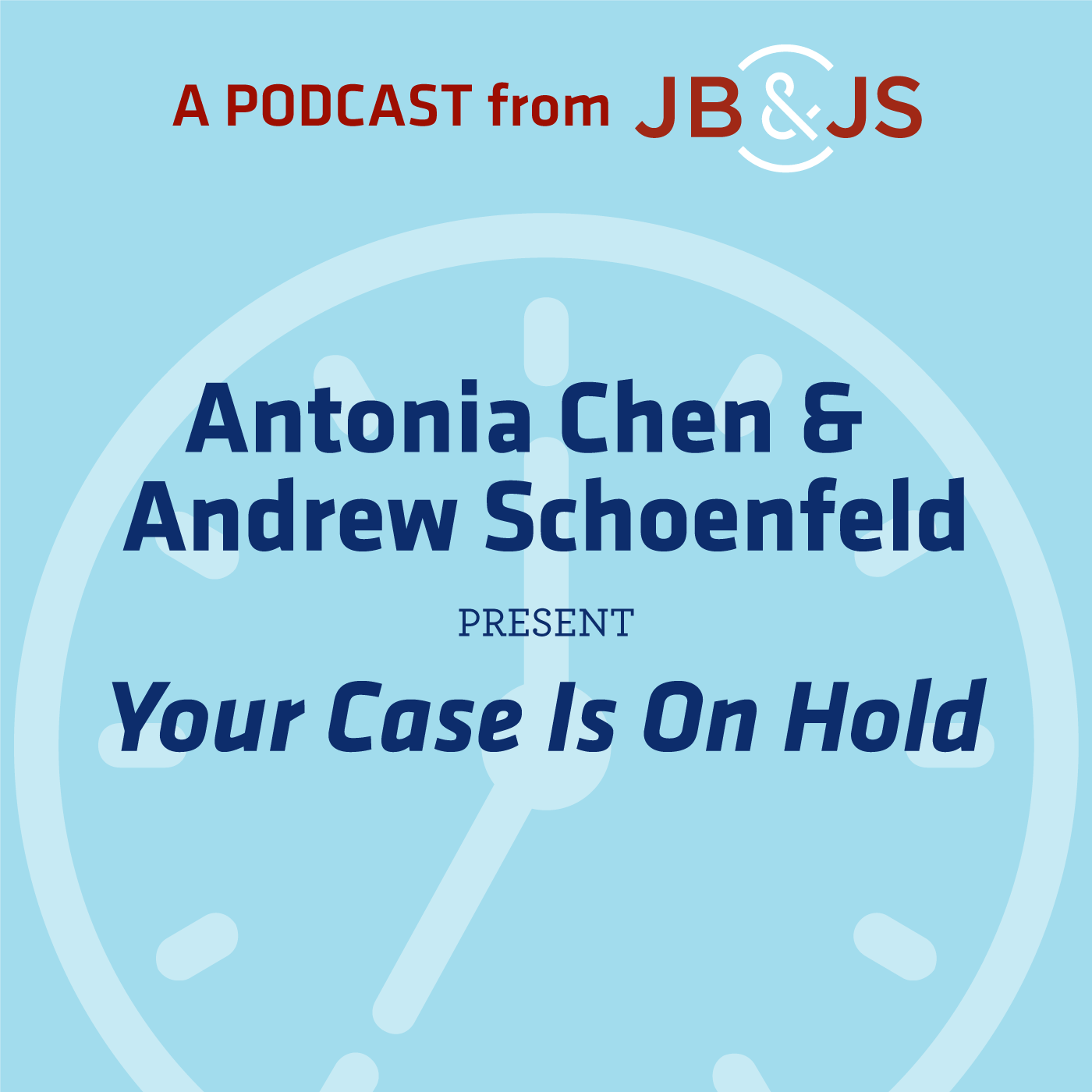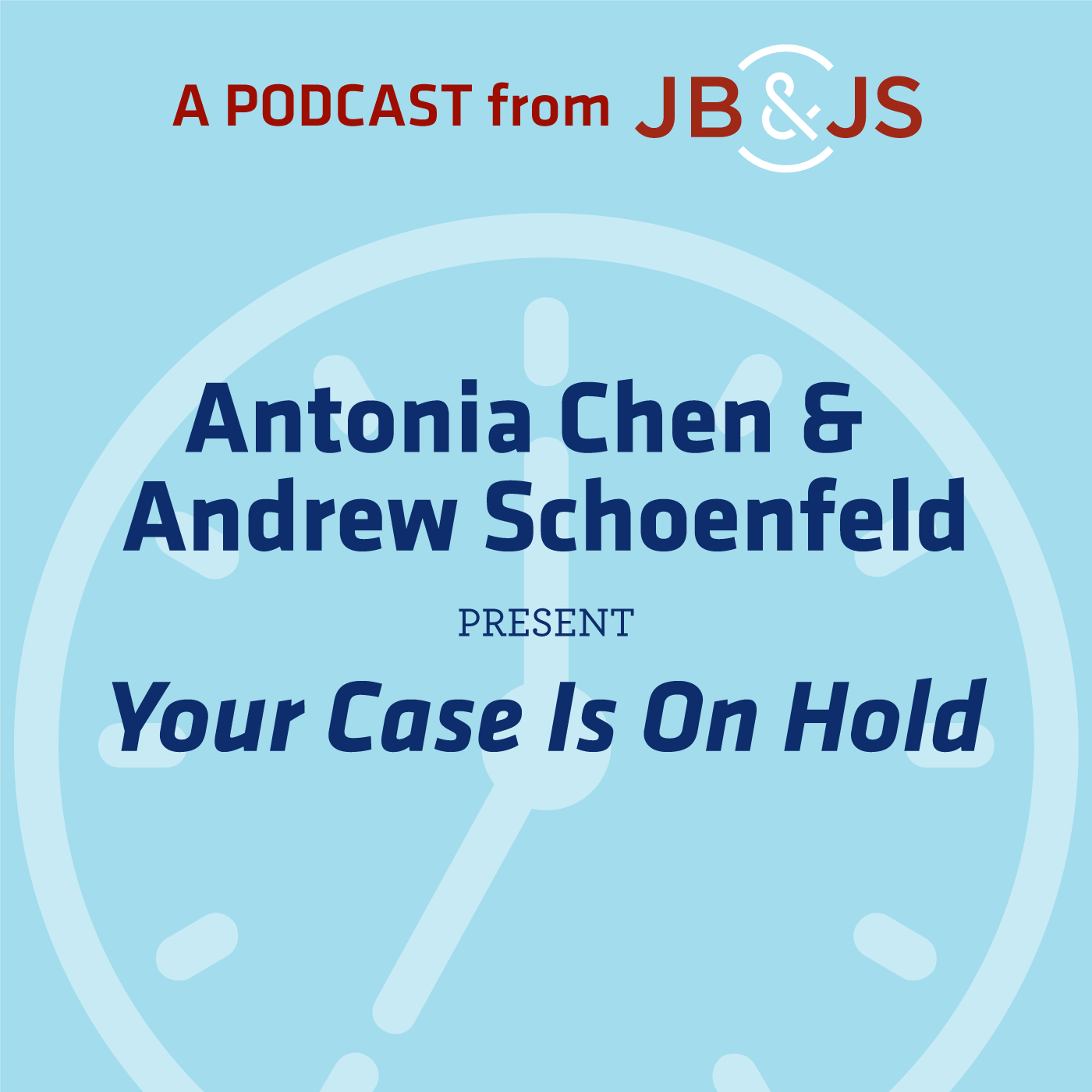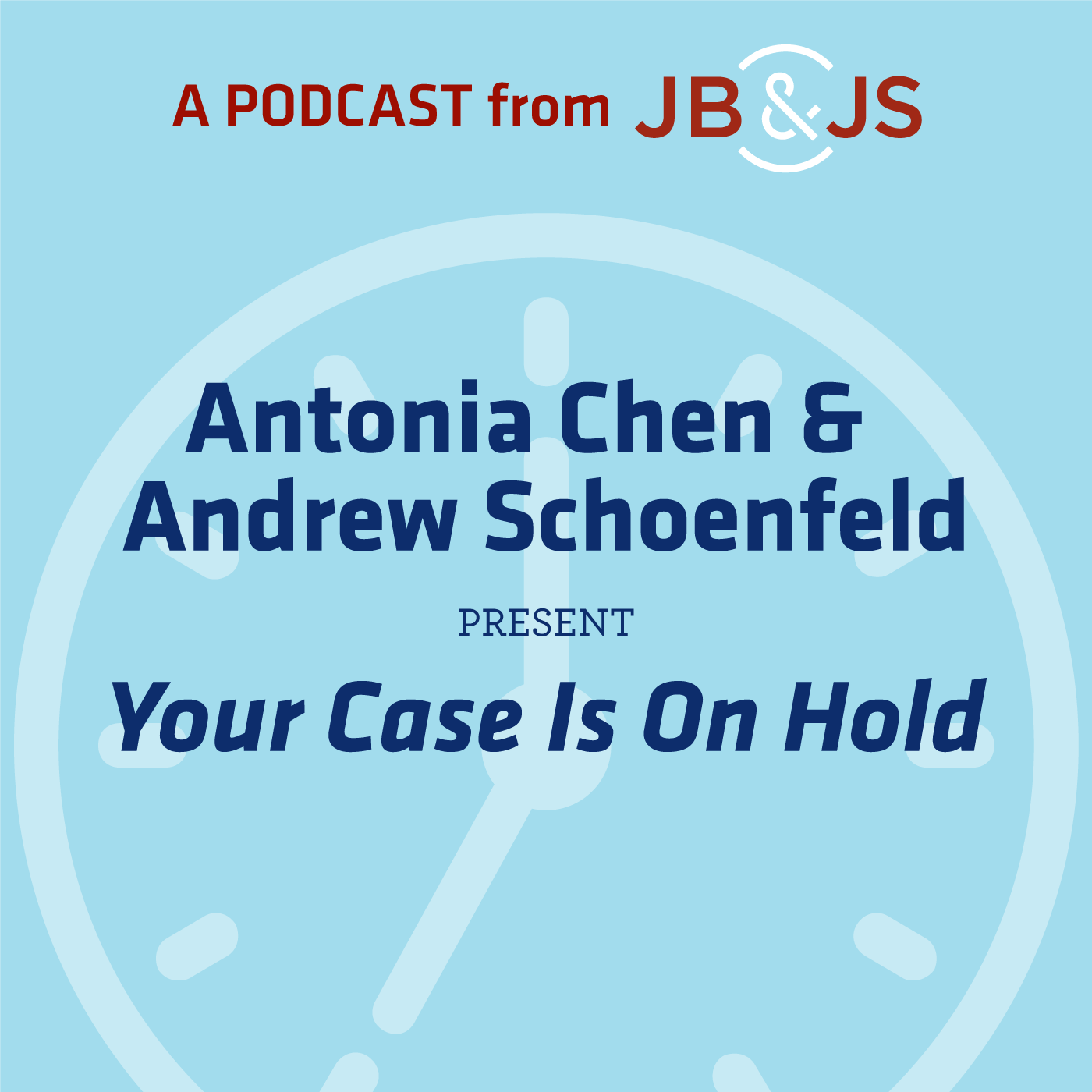Episode Transcript
[00:00:03] Speaker A: Welcome to your Cases on Hold, a JBJS podcast hosted by Antonia Chen and Andrew Stonefield.
[00:00:10] Speaker B: Here we discuss the science of each issue of JBJS with an additional dose of entertainment and pop culture.
[00:00:17] Speaker A: Take us with you in the gym, on the commute, or most certainly whenever your case is on.
[00:00:27] Speaker B: Welcome to episode 92 of your Cases on Hold.
We have quite a listing for you here today with lots of good information and topics to talk about.
We will start by saying that my name is Antonia Chen and I am Executive Editor at jbgs and we have.
[00:00:47] Speaker A: Here I'm Andrew Schoenfeld, Associate Editor for Methods.
[00:00:51] Speaker B: We're thankful that you're all here with us today. Just as a reminder, these opinions are our own and don't reflect anyone else in the JBJS board or any anyone at JB JS at all. This is brought to you by JB JS Clinical Classrooms. If you have some learning that you want to do, we've got some great information for you, so please go there.
It's also the season of oites, so we have options for the OITE Prep bundle as well too, and the OITE Prep Module and the Bundle. So great learning opportunities here, especially for residents. We're taking the OITE really, really good things to study with.
Without further ado, we'll start with our Top of the pile. Top of the pile. Moving Forward with Gratitude by Bhandari. He is our Editor in Chief and it's permanently free to read this what's new in Shoulder and Elbow Surgery? Rao, which is also permanently free.
Home Call and Sleep in Orthopedic Surgeons A prospective longitudinal study of the effect of home call on sleep and Orthopedic Attending surgeons and residents by Lawson. It's free for 30 days and there's a visual summary.
Resident Unions and Orthopedic Surgeries by Lundy et al.
Why am I conflicted about enrolling my patients in a randomized controlled trial? And ethical analysis by Krupa.
We also have principles of level selection for instrumentation in adult thoracolumbar spinal deformity surgery. Guidelines for Surgery by Sidar.
Multi Rod constructs and Spine surgery by Benson.
Finally, topical versus systemic tranexamic acid to reduce blood loss after total knee and total hip arthroplasty. A systematic review and meta analysis. We covered this in our last episode Talking about transomic acid. Now you can see an aggregate of a bunch of different studies in the total joint world.
Without further ado, we're going to go to our headlines. Dr. Schoenfeld is going to start us with Pediatric Spine Frailty index. Predicts morbidity and mortality following spinal deformity surgery by Chanadol. And it is permanently free.
[00:02:49] Speaker A: Can I just say before I start that one, I hate Oite. I hated Oite season. Like, basically from.
From Labor Day until whatever that was, like, the first Saturday in November. Like, I just felt like I needed to, like, anytime I wasn't like, working clinically or in the. Or I needed to be, like, studying for the Oite.
It was such.
It, like, ruined the month of October for me all the time.
[00:03:19] Speaker B: And then you probably crushed the oit, right?
[00:03:23] Speaker A: I did well on it. Yeah.
But nonetheless.
And I also hated home call because I felt like you never got. You don't actually sleep all that well. You're constantly chat. Or at least I would. I'm like, oh, did I miss a page? Like, did I sleep through a page?
[00:03:39] Speaker B: Like, no breaks.
[00:03:40] Speaker A: And then it's like, you know, you come in the next day, you're tired, you're worn out, and they're like, oh, you didn't. You were home, like, full day, full work day. Like, I know, I know that, like, the generation before us, they just lived in the hospital or whatever. Like, they, you know, walk to school barefoot both ways and homework.
All right, so Pediatric Spine Frailty Index. This study, someone who knows that we do these, who's a friend, actually called me up and was like, I can't. Like, are we. Are we're going to be back to publishing NISQIP studies in JBJS now?
So, you know, I cautioned them that this is not like an invitation to submit all your NISQIP work to jbjs. I'm sure that's not what the intent was behind publishing this. And no, I don't think that the average NISQIP study is going to have a high likelihood of success going forward in the journal. But nonetheless, this was a study that was conducted with pediatric miscript data.
And essentially, they were looking to create a prediction score for morbidity and mortality following spine deformity surgery. And the outcome of interest was a composite. Any adverse events. Cleveland Dindo, grade four adverse events, mortality, and extended length of stay within 30 days after surgery. The adverse events included superficial surgical site infection, deep infection, organ space infection, wound destruction, dehiscence, pneumonia, unplanned reintubation, progressive renal insufficiency, acute renal failure, UTI coma for greater than 24 hour stroke, seizure, cardiac arrest, cardiopulmonary resuscitation, VTED post operative C diff, sepsis, septic shock and catheter related clabsi essentially.
So, you know, some of these are quite serious, others are uti and there's a broad variation in terms of, you know, impact and long term outcomes associated with these adverse events.
What they, their approach was they initially did what they're calling univariable. They really mean bivariate comparisons looking for significant associations and then any that they found that were significant. They included a multi variable regression model which then they performed backwards selection using the likelihood ratio to exclude variables without significance in the multivariable context. And then each comorbidity was assigned a score of one in an unweighted index and the other was a weighted index assigned on the basis of the regression coefficient which they term as beta.
Ultimately, they found six comorbidities as being significantly associated with the odds of adverse events. Severe respiratory disease, GI disease, cognitive developmental delay, seizure disorder, neuromuscular disease and asthma.
They did these unweighted where it's just account. They did it weighted where the respiratory disease, seizure and Asthma were assigned 1, GI was 2 and then cognitive delay and neuromuscular disease was 3.
Ultimately the weighted index did not perform that well. So they went with the unweighted index.
That ultimately ends up being what they are characterizing as the frailty index.
But you know, to be very exacting here, words have meaning and frailty means something.
And when you talk about frail patients or patients who are have frailty, generally we're talking about elderly individuals primarily with a diminished physiologic reserve. That's sort of the, the underlying underarching concept around frailty. They have diminished physiologic reserve that does not allow them to effectively bounce back from insults, insults to their physiology. Such surgery or a surgery or a fall and a surgery. Yeah, but this is where frailty comes into play. Frailty usually takes, there's lab values associated with it. Serum albumin, there's skin turgor, there's subcutaneous fat, there's. Yes, cognitive impairment can definitely play into those things. Dementia as an avatar, manifestation of frailty, Patients with spinal metastases, patients with chronic infections, low BMI because they're losing so much weight because of their, their illness.
When we talk when, when I say frailty and you have a mental image of a frail person, someone with asthma is not that.
[00:08:55] Speaker B: Right?
[00:08:56] Speaker A: A child with asthma is definitely not that. Yeah, how about, how about a child with a GI disease which again is a very, these are very broad strokes that are prone to ecological fallacy because it's collected the way NISQIP collects and describes them.
A seizure disorder that could be controlled. It may not be controlled. Either way, I've seen lots of kids hearkening back to a pediatric rotation, be it as a resident or as a medical student. Nonetheless, I saw many kids with seizure disorders and diagnoses. I would not characterize them as being frail even. How about if they had the seizure disorder and asthma? No, still not frail. Also, you have severe respiratory disease here and asthma. Like, if you have severe asthma, is that not a severe respiratory disease?
Asking for a friend, I just say.
[00:09:52] Speaker B: Depends on your definition.
[00:09:56] Speaker A: So I don't, you know, what is severe respiratory disease in a pediatric patient? That's not at least, you know, in the ballpark of. I think the most severe, most common pediatric respiratory disease is going to be asthma. To my mind, again, I'm very far removed from my pediatrics rotation. You know, like, the kids haven't been around long enough to smoke enough to have COPD or something.
[00:10:21] Speaker B: Right, like that.
[00:10:24] Speaker A: I know. Of course, there are other types of, you know, they could have cystic fibrosis. Like, I get more frail.
[00:10:29] Speaker B: That's different. Right. Very different from asthma.
[00:10:32] Speaker A: Right. But. But that is one type of severe respiratory disease.
And if cystic fibrosis should be in this description here, then you should. It should be. It should say cystic fibrosis.
[00:10:46] Speaker B: Great. Completely.
[00:10:47] Speaker A: I think this is a misnomer. It's not the pediatric Spine frailty index. It's the pediatric spine Severe Comorbidity index.
[00:11:00] Speaker B: Yeah. Because it is comorbidities. It's all about comorbidities. That's what it is.
[00:11:03] Speaker A: That's what it is.
Cognitive comorbidities. GI comorbidities.
[00:11:06] Speaker B: By definition, it is. Correct.
[00:11:11] Speaker A: It's not frailty. It's not frailty in the sense that we use frailty.
[00:11:17] Speaker B: Yep. Agreed.
[00:11:18] Speaker A: So this is a misnomer as far as I'm concerned. Keep in mind, NISQIP is not purposely sampled nor is it nationally representative. Their outcomes are only limited to 30 days. I would. They recognize all this, of course, but I think this is going to under predict complications. I think that the composite measure is somewhat intuitive and also.
Okay, you know this. How are you going to change? Like, classifications and scoring systems are useful when they can be used to inform care. Change care are easily understood and are clinically relevant.
So you see someone who has a seizure disorder and asthma and maybe cognitive developmental delay, and you say, okay, well, they're at a higher risk for complications after the surgery.
[00:12:11] Speaker B: Okay, yeah, Yeah.
[00:12:13] Speaker A: I mean, what are you, like, you know, you're not, you know, for them, we'll. We'll. We'll use the antibiotic prophylaxis, whereas for the other one, you're not going to. You know what I mean? Like, I don't think it's going to change anything.
[00:12:25] Speaker B: Right. I hear you. And that's the hard part about this. It's not going to move the needle.
[00:12:29] Speaker A: Enough or at all. And you're going to get confusion where people are going to be like, oh, I want to use the frailty index for patients who are frail. And then if they try to look at these characteristics, they'll be like, well, none of these things are actually measuring frailty. Like, how you can get serum albumin on kids. You can get. I'm sure, you know, there are definitely kids who have true frailty. True frailty.
[00:12:52] Speaker B: Right. Able to do certain activities or not being able to do certain activities. But that's not what this is.
[00:12:56] Speaker A: Assessing Morchio syndrome. Right.
[00:12:59] Speaker B: All the glycogen storage disorders. We had to. Right. Yeah.
[00:13:03] Speaker A: The glycogen storage diseases, they all have, like, eponyms with, like, pictures. People's, you know, fragile nail syndrome, fragile hair syndrome.
[00:13:12] Speaker B: True.
[00:13:13] Speaker A: Ellis Van Crevel, you're putting up some.
[00:13:16] Speaker B: Medical stuff that I have not thought.
[00:13:17] Speaker A: About was like, the PET syndrome, the favorite syndrome of the.
The doctor who was the chair at the children's hospital where I did my residency, he just was like, Ellis Van Creevel. He was always talking about it.
[00:13:32] Speaker B: We did lupus. We were pretty boring in comparison.
[00:13:34] Speaker A: Yeah, no, you gotta. You gotta be more esoteric than that.
[00:13:38] Speaker B: True, Very true.
They didn't test out on your oite, though, that's for sure.
[00:13:42] Speaker A: Yeah, I don't. I don't think this is going to show up on the oite.
[00:13:45] Speaker B: Yeah, that's going to be one of the hard.
[00:13:46] Speaker A: I think you're safe. You're safe from the pediatric spine, Mark. Safe from pediatric spine frailty.
[00:13:53] Speaker B: No Kaiser. So in this one, for sure.
So awesome. Well, thank you for presenting that one. We're going to change the narrative a little bit and we're going to switch to another topic.
Talking about maintaining or increasing physical activity is essential for managing cardiovascular and cerebrovascular risks after total knee arthroplasty. It's a nationwide cohort study by park et al. There's a commentary on this.
What are the cardiovascular and cerebrovascular risks after total knee arthroplasty? And does physical activity play a role in this?
Although the exact timing of increased physical activity after total knee arthroplasty remains uncertain. There are studies that show it does increase between 3 to 12 months.
I tell my patients it takes 12 full months to get back to full activity.
That said, I do recognize that patients want to get back to this activity sooner. You're walking right off the bat. You're moving right away, so you have no excuse to not start walking. We did a study where you put your apple watch or your phone and you counted the number of steps that to get back to pre surgical step count we need at least four to six weeks.
But activity is typically lower after total knee replacement than of non total knee arthroplasty patients. And we have no idea how cardiovascular and cerebrovascular diseases contribute to that, especially into the short and long term mortality after total knee replacements. So this is a study looking at total knee arthroplasty patients and the impact of perioperative physical activity on these risks. Based on a nationwide cohort in Korea, they use the National Health Insurance Service of the Republic of Korea which covers 97% of the population.
So that's nice as opposed to you can't do quite that. In the United States, all individuals undergo a national health examination every two years beginning at the age of 40. This is mandatory for everyone.
Patients who underwent a pair of health examinations at two or four year intervals and did not have a diagnosis of cardiovascular or cerebrovascular disease at the first examination were included between 2007 and 2017.
The TKA group obviously comprised of individuals who underwent TKA but it was unilateral TKA and this happened between the first and second second health evaluations and the control group. The non TK patients comprised patients who didn't undergo TK patients and they were initially matched by 1 to 3 ratio by age and sex. They had to have a they had to minute complete a minimum 5 year follow up period after the second examination.
After exclusions which were missing data on activity less than one year between total knee and second health examination, other surgical procedures in the lower extremity within five years they did a one to one propensity score matching between the TKA and non TKA groups. Now this is for my methodology guru here a one to one nearest neighbor matching without replacement was performed using a caliper width of 0.25 of the standard deviation of the logic transformed propensity score. The matched variables were demographic variables such as age and sex. Comorbidity, specifically the Charleston comorbidity Index medication use such as antiplatelets, anticoagulants and statins, and lifestyle behaviors at the year of the first health examination, such as cigarette smoking, alcohol consumption and physical activity levels. So that's why this is nice. They could do all this study looking at it because at each one of these two year checkups, they're looking at their physical activity level.
My PCP doesn't ask me about my physical activity level at all.
[00:17:07] Speaker A: What happens if you don't show up for your thing?
[00:17:10] Speaker B: Off with your head. I'm just kidding.
[00:17:12] Speaker A: They're like, oh, then you're not a problem for the health system anymore. Because you're not.
[00:17:19] Speaker B: No idea. I have to ask someone who's Korean. I'm not asked. This is kind of interesting.
So they labeled physical activity as the basis of frequency based on moderate to high intensity activities. So what does that mean? So in terms of frequency, you had inactive or active one times per week, also one to two times per week, three to four times per week, or five or greater times per week. What were moderate intensity activities? Those included brisk walking, doubles tennis, cycling at a moderate speed, carrying light objects upstairs and household cleaning. High intensity activities were running aerobics, cycling at high speeds, heavy construction work and carrying heavy items upstairs. They did a Cox proportional hazard models to evaluate the association between physical activity change and disease incident over a 5 year follow up. Remember after the second visit, compared with controls who didn't undergo total knee arthroplasty, total knee arthroplasty patients exhibited higher incidences of cardiovascular diseases and 19% versus 17% and cerebrovascular diseases 26% versus 24%.
These incidences were associated with perioperative physical activity levels, meaning higher physical activity levels after total knee arthroplasty were associated with lower risk of both disease.
Specifically, if you did physical activity greater than or equal to five times per week, it was linked to lower cardiovascular risk and cerebrovascular risk if you were previously inactive. The greatest reduction in cardiovascular disease risk was observed among those who began exercising greater than equal to five times per week. You went from not exercising pre total knee and you started exercising five plus days after total knee arthroplasty. Those are some dedicated patients. And that does help you.
It does reduce both of them. Sorry. It reduces your cerebrovascular disease. Sorry. Cerebral rapid disease has a greatest reduction in cardiovascular disease.
The greatest reduction in cerebrovascular disease were found in those who became active three to four times per week.
So even if you became active at Least three times per week after total knee arthroplasty, you can reduce your cerebral vascular complications. If you go five plus, you can reduce your cardiovascular complications.
However, if you used to be physically active before a total knee and stopped being active after a total knee replacement, then your risk of cerebral vascular disease increased. If you went from greater or equal to five times week exercise to no exercise, that was the greatest risk. So don't stop moving after total knee. In fact, learn from those who were inactive beforehand and became more active. That is the most interesting part of things. So initiating physical activity may be a core component of optimizing long term outcomes after total knee replacement. Now, it doesn't take into account anything like patient satisfaction, walking ability, those type of things that, you know, we say 20% of patients are potentially dissatisfied after knee replacement. Can they exercise five plus times a week? And what does this exercise look like? They did say some exercises that were there, but what does weight training fall where some of these things taking a walk, What's a rigorous pace? What's not a rigorous pace? What about light exercise, things like that? So it's nice to have these health data points, but more detail would have been nice to better understand this.
[00:20:34] Speaker A: Yeah, as far as the propensity score match goes, it's a very permissive caliber at 0.25. Ideally we'd like to see it more at around 0.1. Also, I don't really understand how a causal inference test fits in this context. I get that. I think they're trying to make the case like these are patients that are very similar to the total knee patients. But that would only really be the case if you could say like these are patients who would be indicated for total knee and then who didn't have it. And I don't think a data set like that is like this is really able to do that effectively.
[00:21:13] Speaker B: Completely agree with you there.
We're going to look at total knee replacement again.
In your case on whole feed juaret at 15 year mortality following periprosthetic joint infection. Total knee arthroplasty, A registry study of 8,642 revisions for infection by Christensen et al. It's free for 30 days.
Mortality after PJI is truly a concern. It's been compared to the mortality rate in the top five cancers and collagen arthroplasty by Benz and Towski et al.
And it is up there. It's not a benign condition. People are like, well I get infected, I get washed out, I'll move on with life no, it can actually result in mortality.
This study looked at mortality over a longer period of time 15 year mortality. It used the data from the Australia Orthopedic Association National Joint Replacement Registry, included all primary total knee procedures performed for osteoarthritis between September 1, 1999 and December 31, 2022. ASA scores were collected starting in 2012 and BMI was recorded starting 2015. The authors used Kaplan Meier estimate of survivorship and standardized mortality ratios based on Australian period life tables to describe mortality rates following revision for pji. They also looked at aseptic revisions, but they excluded ones for fracture and unrevised primary total neoplasty. Additionally, hazard ratios were calculated with multivariable proportional hazard models to assess the impact of the risk factors of age, gender, comorbidities and minor versus major revisions.
Because this is a registry study, There were over 831,000 patients in this study with 644 greater than 644,000 patients with no revision procedures recorded, of which 21% of them died in the study period.
There were over 35,000 revisions that were recorded and 1,200 of them approximately were for fracture which were excluded.
There were 8,642 first revisions for PJI, which is the number that's in the title, of which 26.2% of them died and then the aseptic first revision group about 18% of them died.
What happened at five years after surgery? If you had a revision for PJI 16.1% died at 10 years 34.4% and at 15 years over half the patients died. So 53.4% of patients with a revision for PGI died. When you adjusted for age, gender and calendar year of the procedure, the standard mortality ratio for revision was 1.33. How does that compare to aseptic revision? That standardized mortality ratio was 0.84 and for unrevised primary total neoarthoplasty was 0.79.
So the take home message here is that patients with revision for periprosthetic joint infection had a 33% greater than expected mortality compared to aseptic revisions and primary total knee patients.
What were associated with increased risk of mortality? Probably not surprisingly increased age and higher asa. What does that mean with patients who are greater than or equal to 75 years of age? Compared to those who are less than 55 years of age there was a hazard ratio of 9.3.
They also found it increased standardized mortality ratio for younger primary total knee arthroplasty patients compared to older primary total knee arthroplasty patients and younger revision patients compared with older revision patients, especially those with revision for infection.
Patients who underwent revision for infection also had ASA scores of 3, 5 and had higher mortality compared to ASA scores of 1. 2.
Male patients had a higher overall risk of mortality.
However, females with revision for infection had a higher standardized mortality ratio compared with males with the revision for infection.
Underweight status and obesity greater than class 2 had increased mortality.
Patients who had a BMI of 25 to 35 though had the lowest mortality rates compared to the general population.
Try to get your BMIs optimized even before infection surgery, although that's very hard to do. Obviously, patients who were Categorized as obese Class 3 had the greatest mortality rates compared with their matched populations. Minor revisions for PGI were associated with increased mortality within the first five years, but there were really no differences between minor and major revisions for infection after 1.5 years.
Be careful with PGI. PGA's are bad. There was high mortality in the early post operative period and the excess mortality did persist up to the 15 year mark in the study.
Not surprisingly, mortality was unsurprisingly worse for patients who were older and higher ASA scores or had worse comorbidities. Patients male, underweight or obese also had increased mortality. These population studies are interesting. I wish there was more granular data on this to really understand mortality and reasons for it. Mortality itself is not necessarily due to the PJI per se, but it was an indicator probably of their poorer health if they were to become infected.
[00:26:24] Speaker A: So I just have a couple of points that I wanted to make on this mortality risk study. Essentially the question for me is really one why the patients are having the risk of infection.
And I think it is telling in that regard that the ASA, they only had that since 2012, so they don't have it for the earlier sets of patients.
While they did account for the year of surgery, I do think there are still secular trends that are not effectively controlled for between how these surgeries were done and the potential infection risk in 1999 versus say 2022. Then also when they're talking about 15 year risk, that's not for patients who had surgery in 2022, that's really for patients who had surgery from 27 and earlier.
So you're not really getting a good assessment of the baseline comorbidity risk. Are the patients passing away just because of the infection or is it a chicken and egg kind of phenomenon where the infection is a manifestation of their not to belabor or bring up frailty again, but really frailty or baseline risk of adverse events. And it's through that mechanism that that is why they're just.
And I do think that there is some potential for that. And that's why you're seeing the difference between like the younger patients and the older patients that they were showing. Because a younger patient who develops an infection may have a different sort of biophysiologic profile from an older patient who develops their infection or doesn't develop an infection. The younger patient should be more resistant to developing an infection such that when they do develop an infection, it's really showing that this person is in a a totally different landscape and may be at greater risk for mortality as a result. There's also a higher risk of mortality. Right. For the aseptic revisions as compared to the unrevised primary total knee arthroplasties.
And how that comes about is probably.
[00:28:29] Speaker B: I agree with you.
[00:28:30] Speaker A: Yeah, there's a certain burden to having another surgery or multiple additional surgeries.
[00:28:35] Speaker B: I agree.
Not benign.
All right, going to our honorable mentions. Starting off with the outcomes of extraarticular subtalarthrodesis for valgus deformity of the hindfoot in patients with cerebral palsy, a radiographic and pedobarographic study by park et al with an infographic extraarticular subtalar arthrodesis is generally been recommended for treating severe valgus deformities of the hind foot in patients with cerebral palsy. However, it's unknown whether restricted subtalar joint motion affects the shape of the foot during continued growth in children. The purpose of the present study was to evaluate the effectiveness and longevity of extra articular subtal arthrodesis and ambulatory patients with spastic cp with a specific focus on its impact on the final foot shape and plantar pressure distribution. Extraarticular subtal arthrodesis was associated with the high risk of progressive hindfoot varus deformity in patients with cp. And the study findings highlight the need to reevaluate traditional surgical indications for correcting hindfoot valgus deformities.
They have been largely based on the severity of deformity observed on radiographs.
The next one is distinct three dimensional morphologies of knee arthritic knee anatomy exist, CT based phenotyping offer outlier detection and total knee arthroplasty. By Wu et al.
Disclosure I'm an author on this paper and this is a very interesting paper in my mind at least because it classifies patients into four different types the CT based phenotyping had a 3D classification of arthritic knee anatomy and there were types 1 and 3 that represent outliers that's present in 26% of knees undergoing total neoplasty. Prior classifications emphasize native coronal plane anatomy, but this 3D phenotyping of knee allows recognition of outlier cases and provides a foundation for longitudinal evaluation in a morphologically diverse and growing surgical population.
Type 1 outlier has increased femoral version and torsion and increased acetabular version, greater amount of slope like 89 degrees of posterior slope and extreme TFA deformity and then it's more common in women and more Common Valgus. Type 3 on the other hand is decreased femoral version and torsion kind of opposite of type 1, decreased acetabular version 0 or reverse posterior slope and more common in men and more common in varus to four deformities. The wild types are type 2 and type 4, so they have both have intermediate vemo version and torsion the relatively lower acetabular version of type 2 versus relatively higher acetabular version of type 4, similar posterior slopes 5 to 6 degrees.
Type 2 is more common in men, nearly even varus valgus distribution and larger bone size compared to type 4 and type 4 is smaller bone size and more common in women and much more common in various deformities.
And finally, assessment of the mechanical performance of an affordable external fixator is called AFIX A E F I X designed for resource limited settings by Mohammed et al and there's a commentary.
Current external fixator assemblies are unaffordable and they cost upwards of $5,000 of US dollars and most low income countries cannot pay for this and they have to rely on donations because the patient population cannot afford that. There are new affordable external fixator clamps called AF and it's designed for use in these low income country settings and they were compared to some of the standard of care clamps the Hoffman 3.
They looked at mechanical efficacy in axial torsional and loading scenarios, mechanical testing at the component level and construct level and they looked at a uniplanar external fixation of a tibial diaphyseal fracture. It found that the APHIX clamps were comparable to industry standard Hoffman three clamps in terms of mechanical property both cyclical loading and just torsional stress suggested that these affix clamps may provide safe external fracture fixation in non weight bearing especially in a low income countries.
So it's very very useful because the cost is much more effective. Thanks for joining us again, and we look forward to having you next.

